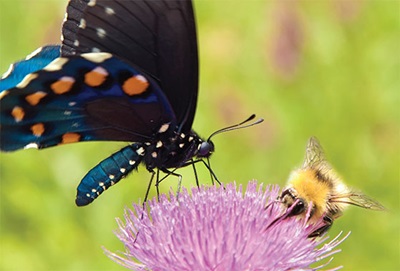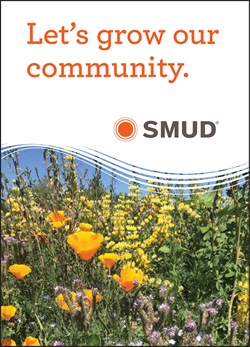Preserving pollinators, protecting our food
Did you know that pollinators like bees, birds, bats and butterflies are responsible for bringing us one out of every three bites of food?

Pollinator populations are in serious decline and many are at risk due to sprawling development, habitat loss, climate change and pesticide use.
SMUD and other energy utilities manage extensive transmission and distribution rights-of-way and influence land resources at wind and solar farms. We are mobilizing to help support pollinator populations.
Our pollinator efforts
We're a member of the Electric Power Research Institute’s (EPRI) Power-in-Pollinators initiative, which exists to promote and support pollinator conservation among energy utilities. The partnership shares the latest scientific findings, case studies and tools to assist with the integration of pollinator-friendly practices into utility vegetation, facilities and land management.
Native seed packets
As part of our pollinator efforts, we give away native seed packets at SMUD events. The species in the packet include:
- White yarrow, Achillea millefolium
- Elegant clarkia, Clarkia unguiculata
- California poppy, Eschscholzia californica
- Gumplant, Grindelia camporum
- Common Sunflower, Helianthus annuus
- Baby blue eyes, Nemophila menziesii
- California phacelia, Phacelia californica
- Tansy phacelia, Phacelia tanacetifolia
- Alkali sacaton, Sporobolus airoides
- Purple needlegrass, Stipa pulchra
- Vinegar weed, Trichostema lanceolatum
Planting instruction
- Sow seeds in early to mid-fall or early spring in full sun or part shade.
- Rake soil surface to create grooves in the soil and scatter seeds by hand.
- Gently rake again or press seeds into the soil. Do not bury seeds.
- Water thoroughly and keep soil moist for 4−6 weeks. Gradually reduce watering.
- Funding and technical support for a pollinator habitat demonstration with educational signage adjacent to the bike trail on the American River Parkway near Cal Expo. This was a joint project with the Pollinator Partnership, the American River Parkway Foundation, Sacramento County Regional Parks and Pacific Gas & Electric Company (PG&E). After three years of study and comparison to conventionally managed sites, the demonstration was found to have twice as many pollinator species, three times the number of bees and 30% higher bee nesting rates.
- A collaborative effort with the Utility Arborist Association, the United States Forest Service, PG&E and scientists at the Sonoma State University Center for Environmental Inquiry to evaluate the impact of Integrated Vegetation Management (IVM) on plant communities and wildlife diversity. This study is taking place in an El Dorado County transmission corridor that was burned in the 2014 King Fire. Research on multiple test plots, including vegetation management cost and revegetation success, is ongoing.
- A multi-year research project investigating the integration of pollinator-friendly native grasses and wildflowers, grazing management and soil carbon storage for a utility-scale solar project. The Restorative Energy project includes seeding within the solar arrays, native pollinator hedgerows and demonstration gardens planned for SMUD’s Rancho Seco Recreation Area, which receives over 100,000 visitors every year. The findings from this project will allow SMUD to evolve design specifications and methods to enable these practices in future solar projects.
- Our Shade Tree Program provides customers with an array of flowering trees which provide nectar and shelter for a variety of pollinators.
- We’re using goats and sheep to graze dry grass and brush in our transmission corridors and other land holdings, reducing the need for herbicides.
- We employ local and non-profit extraction services instead of insecticides when bee colonies need to be relocated to safer locations.
- We eliminated the use of herbicides containing glyphosate in the landscaping at our Sacramento County buildings. We regularly evaluate available weed control alternatives in our Integrated Vegetation Management program and we work to minimize the use of herbicides throughout our system.
Additional resources
Pollinator fact sheets
- Preserving pollinators, protecting our food
- Plant trees for pollinators
- Plant shrubs for pollinators
- Visit a local pollinator garden
- Meet the SMUD beekeepers
SMUD Rancho Seco Restorative Energy Project
- Reimagine energy supporting communities, ecosystems, and climate – Restorative Energy
- Create 20 acres of pollinator habitat under solar panels, measure changes in energy, soil carbon, and management costs.
- Educational native pollinator gardens for 100,000 annual visitors.
- Engage next generation of workforce in sustainability and energy science.
- Coordinate interests of local tribes, shepherds, solar owner and operator, and the protected California tiger salamander.
- Research Project information
Other Research
Power for Pollinators documentary
Power for Pollinators explores that as electricity flows through the landscape, power companies can help pollinators flow through the ecosystem. The film was created in collaboration with the Electric Research Power Initiative. It released in 2020 and has received many international film awards. Watch the Power for Pollinators documentary.




